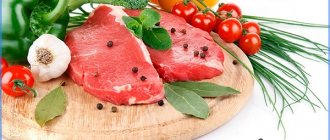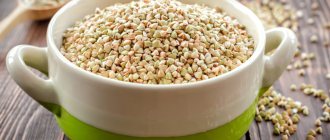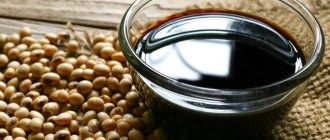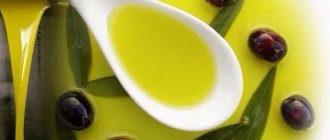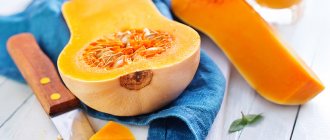Tuna is often used for weight loss because... This is a low-calorie product: 100 g contains 101 kcal. Fish contains little fat but is rich in protein. Dishes prepared on its basis are used to combat excess weight. Tuna in its own juice contains even fewer calories, so this product is most often included in the diet menu.
Composition and beneficial properties of tuna
A large number of useful substances contained in fish have a beneficial effect on the body. The most valuable component is polyunsaturated fatty acids Omega-3 and Omega-6, which bring great benefits to the cardiovascular system, improve brain function and the appearance of the skin. Meat is rich in vitamins, amino acids, macro- and microelements, thanks to which the musculoskeletal and immune systems are strengthened.
Tuna contains:
- proteins, fats;
- B vitamins;
- macroelements: calcium, potassium, chlorine, phosphorus, sulfur, sodium, magnesium;
- trace elements: - iodine, iron, zinc, chromium, fluorine, nickel, copper, manganese, cobalt;
- sterols: Omega-3 fatty acids, cholesterol;
- saturated fatty acids.
Due to the large amount of protein, tuna is included in the diet. Anyone who wants to lose weight in the stomach and other problem areas should use this product every day.
Fish contains iodine, so its regular inclusion in the diet helps prevent the development of thyroid diseases caused by a lack of this element. In addition, weakness, impotence, and chronic fatigue, which are the first signs of iodine deficiency, disappear.
Macro- and microelements, as well as B vitamins, have a positive effect on the condition of nails, hair and skin. Fatty acids and some minerals have a beneficial effect on the cardiovascular system. Regular consumption of tuna helps reduce the risk of heart disease.
Such fish is considered a safe and environmentally friendly product, since its meat is rarely susceptible to infection and parasites. But you should still eat it after special processing.
Tuna is often included in the diet to prevent cancer, because... Scientists have proven that regular consumption of meat reduces the likelihood of tumors.
The rich composition of fish has a positive effect on the nervous system. Dishes based on it lift your spirits and give you a charge of vivacity. The use of such a product increases resistance to stress, since nervousness and stress become the causes of the development of many serious diseases.
Including fish in your diet can normalize blood sugar levels and reduce cholesterol. Tuna is used as a preventative against arthrosis and arthritis. Its meat reduces pain in joint diseases.
Micro- and macroelements
The benefits of fish and the amount of kcal are determined by its composition, concentration of vitamins and elements. Tuna contains many substances that help the body systems function normally:
- a large amount of vitamin PP (niacin), which replenishes 77.5% of the daily requirement per 100 grams of seafood;
- vitamin B6 (pyridoxine) replenishes 40% of the norm;
- vitamin B1 thiamine is concentrated in a volume of 20% of the daily dose;
- phosphorus calculated at 35%;
- sulfur in a ratio of 19%;
- potassium – 14%;
- Among the microelements, chromium, iodine, and cobalt stand out, 100 grams of which provide 400%, 180% and 33% of the daily requirement.
The calorie content of tuna or the energy value of the product, kcal, shows the amount of energy that the body receives from the product during its digestion.
Among the microelements, chromium, selenium and cobalt stand out. The latter substance renews cells, removes cholesterol, and slows down the aging process. Cobalt helps proteins and fats to be synthesized faster. Chromium can have a positive effect on heredity by maintaining DNA integrity.
Macronutrients are as important as micronutrients. 300 g of tuna eaten covers the daily requirement of phosphorus. The substance takes part in the formation of cells. 100 g of seafood contains 190 mg of sulfur, which is equal to 19% of the norm. The substance is necessary for healthy skin, bone tissue, and improved hair condition.
The benefits of dieting
By eating tuna during a diet, you can lose up to 2 kg of excess weight in 3 days, because... it contains few calories. During these days, fish should be consumed every day. This product is rich in protein, which improves body functions and builds muscle tissue, but does not add fat to the body.
With such a nutrition system, you need to drink 1.5–2 liters of liquid. This could be non-carbonated mineral water and green tea. During this technique, tuna is consumed fresh or canned, it is used for snacks and salads.
Selection of canned tuna in its own juice
When planning to buy canned tuna, pay attention to several factors:
- Canned food was made at least 3 months ago: this is exactly the time required to obtain a delicate taste;
- The fish pieces should be dense and large. Cheap canned food, as a rule, contains only fish “rot”;
- Shake the jar: the more liquid there is, the less room there is for the fish.
Delicious sandwiches, pies and pasta, soups and salads - you can prepare a huge number of delicious dishes from tuna. But tuna's best partner is rice. This is a well-coordinated duet, the benefits of which have been tested for centuries.
Tuna Diet
During the tuna diet, it is important to maintain proper nutrition to effectively lose weight. It is recommended to serve fish with side dishes of steamed, boiled or fresh vegetables. The most useful are zucchini, beets, cabbage, carrots, legumes, spinach, celery, asparagus, bell peppers, cucumbers, and herbs. This product goes well with brown rice seasoned with soy sauce.
Tuna goes well with vegetables and herbs
The menu includes lean poultry, seafood, eggs, cereals, whole grain bread, low-fat dairy and fermented milk products. Drinks allowed include fruit and vegetable juices, jelly, fresh juices, nectars, smoothies, berry fruit drinks, plain water, rosehip decoction, herbal and green tea.
During the tuna diet, you should avoid the following foods:
- bakery;
- smoked meats;
- fried and fatty foods;
- marinades, gravy, dressings;
- mayonnaise, sauces;
- spread;
- pasta;
- pickles, marinades;
- fast food;
- sweets;
- sweet fruits - persimmon, melon, dates, grapes, figs, bananas.
The fish diet should last 3 days. As a result, during this period you can lose 1–2 kg.
Sample menu for 3 days:
- Breakfast: boiled egg, 100 g cottage cheese, 200 g low-fat yogurt, green tea.
- Snack: 200 g of steamed or boiled fish, orange.
- Lunch: 250 g fish fillet, sprinkled with lemon juice, salad of sweet pepper, cucumber, cauliflower and green beans, seasoned with olive oil. 30 minutes before lunch you should drink a glass of herbal tea or plain water.
- Dinner: consists of the same food that was at lunch, only in this case you can replace tuna with seafood, and instead of salad, cook rice with saffron.
The combination of tuna and eggs is a real protein bomb for the body.
Before going to bed, it is recommended to drink a glass of low-fat kefir. This menu is repeated for 3 days.
There is also a longer version of the fish diet, which lasts a week. In this case, you can lose 3–4 kg in 7 days. At the same time, you need to exercise and drink enough water. Between lunch and dinner you are allowed to snack on 150 g of berries or unsweetened fruits.
A sample menu for 7 days is as follows.
Monday:
- Breakfast: 150 g of boiled or steamed tuna, Chinese cabbage with watercress leaves, green tea.
- Lunch: vegetable puree soup with bell peppers, broccoli and celery, a portion of brown rice with pieces of tuna.
- Dinner: 150 g of boiled squid, Korean carrot and kelp salad, whole grain toast, herbal infusion.
Tuesday:
- Breakfast: stewed flounder, cauliflower, orange juice.
- Lunch: pickle soup with rice, steamed tuna cutlets, a piece of whole grain bread.
- Dinner: 200 g of tuna in its own juice, a piece of whole grain bread, a handful of nuts, herbal decoction.
Wednesday:
- Breakfast: a sandwich of bell peppers, lettuce and lightly salted salmon, green tea.
- Lunch: lean green borscht, to which add chopped boiled egg, steamed tuna.
- Dinner: 300 g of shrimp with spices, watercress leaves, fresh apple juice.
Tuna soup - a nutritious lunch dish
Thursday:
- Breakfast: 150 g of boiled tuna, 1 cucumber, a piece of bread, herbal decoction.
- Lunch: rich fish soup with pieces of red fish, chicken egg, watercress leaves.
- Dinner: boiled squid with pineapple, a piece of bread, tangerine juice.
Friday:
- Breakfast: 150 g of steamed cod, a piece of whole grain bread, green vegetable salad, green tea.
- Lunch: vegetable soup, a portion of brown rice with saffron, pieces of flounder fillet.
- Dinner: boiled mussels with basil, celery stalks, garlic, a piece of bread, berry juice.
Saturday:
- Breakfast: 2 rye flour pancakes with red caviar, green tea.
- Lunch: fish soup, baked tuna with lemon, kelp, Korean carrot salad.
- Dinner: steamed fish cutlets, stewed carrots with zucchini, berry jelly.
Sunday:
- Breakfast: boiled catfish with celery root and ginger, fresh citrus juice.
- Lunch: green lean borscht, chicken egg, piece of boiled tuna, piece of bread.
- Dinner: 200 g of shrimp, vegetable salad with olive oil, a piece of bread, herbal decoction.
Fresh tuna is best boiled
Chemical composition
For the full and coordinated functioning of internal organs and the proper flow of all processes in the human body, vitamins, nutrients and minerals, micro- and macroelements are needed. We mainly get them from outside, or more precisely, from food.
Anyone, even a child, will say that to feel good you need to eat well. Making a balanced diet is not an easy task. Nutritionists say that at least once a week there should be fish or other seafood on our tables.
Unfortunately, not everyone likes such dishes. We have to look for an alternative. This is where canned tuna appears on the home menu. The calorie content of tuna fillet varies. If you eat tuna in its own juice, the nutritional value of a 100 g serving is only 96 kilocalories.
But for lovers of canned fish in oil, the calorie content of tuna is a surprise. The nutritional value of tuna pieces in golden oil reaches almost 200 kilocalories, also per 100 g of product. The difference is significant, you will agree.
In any case, tuna fillet is a storehouse of micro- and macroelements and vitamins. Canned tuna contains the following ingredients:
By eating canned tuna fillet once a week, you can compensate for the deficiency of magnesium and iron. This delicious seafood is enriched with B vitamins, and as you know, they are considered the building material of our nervous system.
On a note! The cost of chilled tuna fillet is quite affordable, but the price of canned fish is much lower. By consuming canned fish in its own juice, you can replenish your vitamin and mineral reserves and normalize the functioning of your entire body.
Efficiency in losing weight
The effectiveness of using tuna for weight loss lies in the fact that it is a low-calorie product. Thanks to the high content of Omega-3 fatty acids in fish, the body functions properly and receives enough energy for the whole day. This nutritional system includes the consumption of other healthy foods, including vegetables and fruits. They are nutritious and make it easier to endure a strict three-day diet.
The reason for the effectiveness of the tuna weight loss technique is that this product contains little fat (0.8% per 100 g). Moreover, these fats are unsaturated, i.e., considered healthy. Such food contains a lot of protein (28% per 100 g), which does not allow fat to be deposited in the body.
A tuna nutrition system will help you lose weight if you adhere to the following rules:
- You should exercise regularly. Every day you need to spend 30 minutes on this. If you can’t do this every day, then you can go to the gym 3-5 days a week and train for about an hour, which allows you to burn extra calories.
- You need to drink 2 liters of water. This allows you to remove toxins from the body and reduce fluid retention, which causes swelling.
- Fruits and vegetables should be eaten without restrictions. Tuna goes well with them. As a result, the body is saturated with essential nutrients. Vegetables and fruits reduce appetite because they contain large amounts of fiber.
- It is recommended to eat 5-6 times a day. Dividing food into smaller portions reduces cravings between meals.
They drink tea without sugar, and use any vegetables for salad.
In oil
The calorie content of tuna in vegetable oil is 190 kcal per 100 grams. Seafood contains a lot of protein, which breaks down well. The dish contains vitamin A and many useful elements:
This composition can improve metabolism and prevent the formation of cancer cells.
People are interested in how much BJU is contained in the product. 100 grams of canned butter contain 27.1 g of protein, 9 g of fat, and no carbohydrates.
Contraindications and possible harm
Tuna causes minimal harm to health. Like any fish, it can accumulate mercury. Poisoning with such a substance causes the following symptoms: convulsions, numbness, problems with memory and vision. When including canned tuna in your diet, you need to consider how much salt and sodium it contains. To minimize harm, you should use fish in its own juice during the diet and be sure to wash it before adding it to the dish.
This product is contraindicated in the following cases:
- pregnancy and lactation;
- renal failure;
- allergy to this fish;
- children under 3 years of age.
Application
Tuna in its own juice is used everywhere. This fish is good because it retains its taste and beneficial properties even when canned. Tuna in its own juice is the basis for numerous sea salads. In many Asian countries, tuna is consumed raw. This type is very useful, but requires some “preparation” of the body. This fish is also very good when fried. But tuna in its own juice has gained the greatest popularity in canned form. It should be noted that many Asian fish stores have a separate section for tuna.
Tuna in its own juice is an extremely tasty and healthy fish. By including it in the diet, a person ensures the normalization of the functioning of all vital organs.
Market Analytics
- Black Lives Matter movement: reaction and consequences for the beauty industry
- COVID-19 is changing the rules of the game in the cosmetics market
- Beauty of the future: cosmetic innovations 2020
Convenient search for beauty salons on our website
Beauty salons in Moscow Beauty salons in St. Petersburg Beauty salons in Ekaterinburg Beauty salons in Novosibirsk
Latest blog posts on our website
- Naturecream / Apricot kernel oil for face
- Naturecream / MATRIXYL3000 - the best skin elasticity stimulator
- Naturecream / SPF in Natural Oils
- Naturecream / Geranium (Pelargonium) oil for skin health and beauty
- Prostye-sovety / Save on a beauty salon: procedures that can be done at home
- Naturecream / Growth Factor - brings back youth?
- Oksana-Lezina / 3 effective abdominal exercises from a fitness instructor for beginners
- Prostye-sovety / Making perfect curls at home
- Prostye-sovety / Which hair removal method to choose
- Naturecream / Wrinkles Puppets
Latest forum topics on our website
- Natalya / How to properly make a gelatin mask?
- Mrs._Smith / Badly sunburned! What to do?((
- Ice / Is it necessary to combine fitness classes with a diet?
- Antonova / What can be used for hair loss?
- Radio operatorKat / Who was on a protein diet?
Other articles in this section
| Stuffed pike Pike is a freshwater fish. One of the most popular in cooking. Pike dishes are tasty, nutritious, healthy and dietary. A festive table setting is not complete without culinary masterpieces using this fish. |
| Blanched Beluga Beluga is one of the largest fish of the sturgeon family. The average weight ranges from 50 to 250 kg (some individuals can reach a ton). Habitat: southern seas: Black, Caspian and Azov. The fat content is not high - about 9%. Due to the value of beluga caviar, it has been practically exterminated in the seas. The population is maintained by breeding it in artificial reservoirs. |
| Seabass Seabass is usually classified as a premium fish. The thing is that it contains a small amount of bones. It is often also called the sea wolf. The low calorie content of Seabass along with its high gastronomic qualities was noted. It is not surprising that adherents of a healthy lifestyle and gourmets who love seafood love to enjoy them. |
| Hot smoked cod Cod belongs to the cod family and is usually found in the Atlantic Ocean. Moreover, there are several subspecies of this fish, determined by geographical location: Baltic, White Sea, Arctic Cod. The maximum length is 1.8 m, but smaller individuals are caught on an industrial scale. This fish is distinguished by its bright and attractive color with specks, its belly is white, and there is a small antennae on the chin. |
| Fried squid A dish of fried squid is common in countries on the Mediterranean coast. The process of preparing this dish is quite simple, just cut the pre-cleaned squid into rings, roll in wheat or chickpea flour and fry in a frying pan with the addition of vegetable and olive oil. |
| Mackerel in oil Mackerel is a fish from the mackerel family, quite heat-loving and preferably lives in schools. It has an elongated body shape with small scales. The most common mackerel is in the Baltic, North, Mediterranean, Black and Marmara seas, and is also often found off the coast of North America. Most often, mackerel lying on store shelves is of Atlantic or Far Eastern origin. It can be found frozen, canned or smoked. |
| Lobsters (neck meat) Lobsters are very similar in appearance to lobsters; their distinguishing feature is the absence of large front claws. The spines are clearly visible on their shell, and there are also long whiskers. Their meat is a real delicacy, distinguished by its delicate taste and piquant aroma. |
| Whitefish Fish Whitefish belongs to the salmon family, but some scientists distinguish it with certain types of fish into a separate whitefish family. Externally, this fish has characteristic features: it is a compressed body with medium-sized scales, a small mouth, in which there are practically no teeth. If there are any, they are very poorly developed. Habitat: cold countries, preferably located in the northern hemisphere. |
| Crucian carp Crucian carp is, without any doubt, the most common fish. Crucian carp can be either sea or freshwater. Possessing fantastic unpretentiousness, crucian carp takes root in virtually any environment and conditions. Even the most unsightly body of water can contain this type of fish in abundance. |
| Smoked trout Trout is a species of the salmon family. This fish lives in the North-West and Transcaucasia, it can be found in lakes. But in order to lay eggs, trout swim to rivers and streams that flow into the body of water in which the fish lives. But it happens that the fish does not swim away and spawns directly in the lake. Once the fry are released, they separate. Some go to live in rivers and streams, while others return to the lake. |
Recipes
There are many recipes for preparing tuna dishes that are used in proper nutrition.
Diet salad
This dish is well suited for those losing weight who want to quickly lose weight. Diet tuna salads are low-calorie, healthy, tasty, light and nutritious.
The following components will be required:
- tuna - 200 g;
- lettuce - 1 bunch;
- tomatoes - 3 pcs.;
- green onions - 50 g;
- olive oil - 1 tbsp. l.;
- lemon - quarter;
- soy sauce - 1 tbsp. l.
The lettuce leaves are washed, torn into small pieces by hand and placed on a dish. Tomatoes are cut into large slices and placed on torn leaves. The fish is boiled, cut into large pieces and placed on top. Mix olive oil and lemon juice, add soy sauce and season the salad. The finished dish is decorated with finely chopped onions.
With egg
For this salad you will need the following ingredients:
- tuna - 200 g;
- chicken eggs - 3 pcs.;
- low-fat natural yogurt - 50 ml;
- onions - 1 pc.;
- fresh cucumber - 1 pc.;
- greens (onion, dill) - 50 g.
The fish is boiled and cut into small slices, boiled eggs and cucumber are cut into cubes, and onions are cut into half rings. Season with yogurt, mix, place on a dish and decorate with herbs.
Exotic
For this salad you will need:
- canned tuna - 1 can;
- eggs - 2 pcs.;
- banana - 1 pc.;
- grapefruit - 2 pcs.;
- yogurt - 100 ml;
- lemon juice - 2 tbsp. l.;
- ground black pepper - 1 tsp;
- salt - 0.5 tsp.
The banana is peeled, cut into cubes and sprinkled with lemon juice. The grapefruit's skin and white partitions are removed and cut into cubes. Boiled eggs are cut in the same way. Mash the tuna into large pieces with a fork. Pepper and salt are added to the yogurt. Mix all ingredients and season with yogurt.
Mediterranean
For this dish you will need the following ingredients:
- canned tuna - 100 g;
- green salad leaves - 50 g;
- boiled egg - 1 pc.;
- tomatoes - 2 pcs.;
- lemon - half;
- cheese - 30 g;
- olive oil - 2 tbsp. l.;
- salt and ground black pepper - to taste.
Salad leaves are washed, dried, torn by hand and placed on a plate. The tuna is cut into small pieces and placed on leaves. The egg is cut into 6–8 pieces, and the tomato into slices. Place them on the salad and add grated cheese. Mix olive oil and lemon juice and pour the resulting dressing over the dish, salt and pepper.
Types of tuna
There are 15 types of tuna in total:
- Common red tuna
(has the fattest and most exquisite meat among all representatives of the genus). - Skipjack tuna
(ranks first among all species in terms of catch volumes. It is especially popular in Japan as the basis for dried katsuobushi flakes and soups). - Yellowfin tuna
(received its name due to the yellow color of its fins. It has bright red, dense meat, which is widely used in Japanese and European cuisines). - Bigeye tuna
(this species has dense, dark red meat). - Blackfin Atlantic tuna
(as a rule, do not reach large sizes, and serve as food for tuna of other species). - Spotted small Atlantic tuna
(compared to other species, it has lean meat. It is usually used for canning). - Longfin white tuna
(received its name due to its long pectoral fins. Widely used in French and Italian cuisines). - Mackerel tuna
(among other species is distinguished by its small size. Serves as raw material for the production of canned food). - Australian southern bluefin tuna
(owners of dense, delicious meat, which is used in making sushi and sashimi). - Pacific bluefin tuna
(extensively farmed in Japanese aquatic farms. The meat has a dark red tint). - Longtail tuna
(possesses tender white meat, mostly found in the Indian Ocean). - Southern tuna
(compared to other species, their meat is much fattier and lighter in color). - Mackerel tuna
(serve as raw material for the production of canned food. They are distinguished by relatively perishable meat). - Oriental tuna
(mostly found in fresh form on the market). - Small oriental tuna
(used both fresh and dried, salted, frozen and smoked).
Reviews
Veronica, 46 years old, Arkhangelsk: “Several years ago I was diagnosed with type 2 diabetes. The doctor recommended following a strict diet that limits the intake of fats and carbohydrates. For a long time I couldn’t find suitable food until a relative recommended tuna fillet. I boil it with spices and green vegetables. Not only did it help lower my blood sugar, but it also helped me lose a few pounds.”
Marina, 31 years old, Moscow: “I suffer from excess weight, so I tried many ways to lose weight. I recently found information that tuna works well for this. I bought fish in its own juice and use it to prepare low-calorie casseroles and salads. I also use this product for dinner. There is no feeling of hunger, and weight gradually decreases. I am pleased".
Energy value (calorie content) of tuna
The energy value of tuna is average compared to other fish. The amount of calories in a product depends on two factors:
- what part of the fish is taken;
- how the product will be prepared.
From raw fish, fillets, steaks or shavings are obtained, and subsequently these parts, if necessary, are subjected to various methods of thermal or non-thermal processing. You can cook tuna in different ways. This product can be boiled in a pan on the stove, baked in the oven, fried in a pan or grilled, or steamed. Dried, smoked (hot and cold smoked), fresh, salted, canned tuna (in oil, in its own juice) is consumed as food.
© la_vanda – stock.adobe.com
What are the calories in different parts of tuna?
| Raw part of fish | Calorie content per 100 g | BJU |
| Steak | 131.3 kcal | 11.6 g protein, 2.9 g fat, no carbohydrates |
| Shavings | 434 kcal | 81.2 g protein, 1.8 g fat, 0.6 g carbohydrates |
| Fillet | 110 kcal | 23 g protein, 1.7 g fat, 0.2 g carbohydrates |
So, tuna flakes have the most calories, while the difference between fillet and steak is insignificant - only 19 kcal. Next, let's look at how the calorie content of a product differs depending on the method of its processing.
| View | Calorie content per 100 g | BJU |
| Boiled (boiled) | 141.2 kcal | 22.9 g protein, 1.9 g fat, no carbohydrates |
| Fried | 135.3 kcal | 21.9 g protein, 5.1 g fat, 0.1 g carbohydrates |
| Baked in the oven | 162.5 kcal | 28.1 g protein, 5.6 g fat, 0.8 g carbohydrates |
| Canned in oil | 188.4 kcal | 22.4 g protein, 9.9 g fat, no carbohydrates |
| Canned in its own juice | 103.4 kcal | 22.2 g protein, 1.3 g fat, 0.1 g carbohydrates |
| Smoked (cold smoked) | 138.2 kcal | 24.5 g protein, 4.4 g fat, no carbohydrates |
| Smoked (hot smoked) | 135 kcal | 22.5 g protein, 0.7 g fat, no carbohydrates |
| Grilled | 194.2 kcal | 21.3 g protein, 11.3 g fat, 0.6 g carbohydrates |
| For a couple | 123 kcal | 22.7 g protein, 1.3 g fat, 0.5 g carbohydrates |
| Fresh (raw) | 101 kcal | 23 g protein, 3 g fat, no carbohydrates |
| Salty | 139 kcal | 24.5 g protein, 4.5 g fat, no carbohydrates |
| Dried | 160.4 kcal | 34.4 g protein, 4 g fat, no carbohydrates |
The least high-calorie fresh tuna. Next comes canned fish in its own juice, while tuna canned in oil has much more calories.
For those who want to lose weight, steamed tuna is a must, because it only has 123 kcal. Take these indicators into account before eating any processed fish, especially if you adhere to proper nutrition.
How much and how to eat
Tuna is suitable for consumption in any form . No parasites have been found in this fish, and its raw meat is traditionally used in Japan to make sushi.
We are more familiar with dishes in which the fish undergoes preliminary heat treatment. Tuna can be boiled, fried, baked, canned food is used to make salads.
The daily intake of fish for adults is about 50 g per day, but not more than 360 g per week. Nutritionists recommend serving it at least twice a week, for older people - up to 4 times.
Tuna is a dietary product ; it is included in therapeutic and preventive diets recommended for cardiovascular and some other diseases.
This is an ideal product for sports nutrition and body weight correction.
The almost complete absence of carbohydrates means that it can be safely included in the diet of people with diabetes .
If you don’t yet know how sea kale is beneficial for the body, read our publication!
Is it possible to include catfish in the menu while breastfeeding? Find the answer to the question in this article.
This material will tell you how to determine the quality of red caviar when purchasing. Find out more!
How to choose a quality product
Tuna is sold fresh, frozen or canned . The shelf life of fresh and frozen products is limited: fresh fillets are stored for no more than 4 days, frozen fillets are stored for up to 2 weeks.
Fresh tuna fillets are similar in color to beef. Questionable freshness is indicated by the uneven shade of the piece you like.
It's even worse if brownish spots are visible on it.
When choosing a packaged product, you need to carefully study the information on the packaging and the expiration date. The best time for such purchases is May-August.
Canned tuna is more accessible - in its own juice or in oil . Fish in its own juice retains more beneficial properties than fish canned in oil.
If we are talking about a dietary product, take into account that the addition of oil increases the calorie content of the product.
When choosing canned food, carefully inspect the packaging. Cans that are deformed, swollen, or with traces of rust do not deserve your attention.
Then study the markings and information on the label. The marking can be embossed from the inside or applied with permanent paint.
Fuzzy symbols and poor quality paint are indicative signs that the canned food is not of the best quality. The most reliable marking is a convex marking, since it is applied in production, and counterfeiting becomes impossible.
The first row of symbols indicates the assortment code; for tuna it will be the abbreviation GTN. The second row of symbols indicates the date of manufacture.
It is better to take a product released more than 3 months ago . During this time, canned tuna acquires a rich taste.
In addition, it makes sense to shake the jar and roughly assess the ratio of fish to liquid.
Canned tuna contains only fish meat, salt and vegetable oil if you choose canned food with added oil. Products in their own juice retain more beneficial properties and taste richer.
In addition, canning in oil has another pitfall - some manufacturers mix old and young fish, and the oil masks differences in taste.
There are also ethical restrictions. When choosing canned products, it is advisable to look for those that have the “dolphinfriendly” mark on the label.
This means that the fishing was carried out legally, without violating technology and did not lead to the death of dolphins.
Tips for choosing canned tuna:

